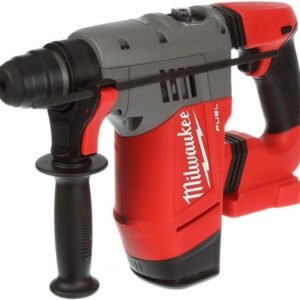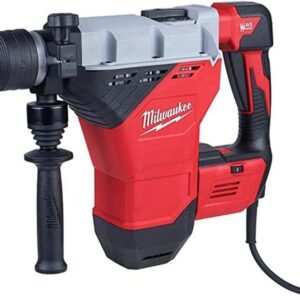Ryobi P222 Rotary Hammer Review Best 18V SDS Drill for Concrete and Masonry
Ryobi P222 Rotary Hammer Review Best 18V SDS Drill for Concrete and Masonry
- Compact design makes it easy to handle and work in tight spaces without fatigue.
- The LED light greatly improves visibility in dimly lit work areas, enhancing precision.
- Offers four versatile modes, including hammer, screwdriver, chisel, and adjustable chisel positions for various applications.
- Its pneumatic hammer mechanism delivers strong impact energy, allowing efficient drilling through concrete and stone.
As an Amazon Associate I earn from qualifying purchases.
Description
Highlights of the Ryobi One+ 18V SDS Rotary Hammer
Testing the Ryobi P222 Ryobi One+ 18V SDS Rotary Hammer (Tool Only – Battery and Charger NOT Included) revealed several standout features. This rotary hammer impressed me with its pneumatic hammer mechanism, delivering 1.3 joules of impact energy that made drilling through concrete and stone surprisingly straightforward. The SDS+ attachment allowed for quick bit changes, which saved me a lot of time during various projects around the house. I found the four operational modes—hammer, screwdriver, chisel, and adjustable chisel position—particularly versatile, making it easy to switch between tasks without swapping tools.
The LED light that illuminates the work area was a thoughtful touch, especially when working in dimly lit corners or basements. Its compact design and lightweight frame (just 1.7 kg without a battery) made handling much less of a strain compared to bulkier rotary hammers I’ve used before. This tool is powered by an 18V lithium-ion battery system, though it’s important to note that the battery and charger are sold separately, which might catch some buyers off guard.
- Efficient pneumatic hammer mechanism
- Versatile four-mode operation
- Quick and easy SDS+ bit changes
Drawbacks Worth Noting
Despite many positives, a few areas could use improvement. The absence of a battery and charger in the package meant I couldn’t test the tool right out of the box, which was inconvenient. The maximum torque of 15 Nm felt a bit underwhelming when tackling tougher materials; drilling through thick metal required more patience than I’d hoped. Additionally, the noise level, around 96.2 dB(A), was noticeably loud, reminding me that ear protection is non-negotiable with this tool.
The vibration levels were somewhat high too, especially during chiseling tasks. I experienced some hand fatigue after extended use, despite the tool’s relatively light weight. The single handle design offers good control but lacks the ergonomic grip enhancements found on higher-end models, which could affect comfort for prolonged projects.
- Battery and charger not included
- Moderate torque performance
- High noise and vibration levels
Versatility and Control
The four modes were a highlight for me. Switching between hammer drilling, screwdriver, chiseling, and adjustable chisel positioning was seamless. This versatility meant I could remove tiles one moment and drill into masonry the next without changing tools. The adjustable chisel feature allowed me to align the bit perfectly for precision work, which was handy on uneven surfaces.
Speed settings also contributed to control. The tool offered three speed variations, with a maximum no-load speed of 1300 RPM and a strike frequency that reached up to 5000 strokes per minute. These settings enabled me to tailor performance based on the task, from gentle tile removal to aggressive concrete drilling.
Usability and Design
Carrying this rotary hammer around felt surprisingly light due to its compact size (11.8″ L x 7.7″ W x 3.4″ H) and manageable weight. The metal body gave it a solid, durable feel, reassuring me it could handle rough job site conditions. I appreciated the LED light placement near the drill bit, which illuminated dusty, dark workspaces effectively.
Although it’s a battery-powered tool, I noticed the absence of a battery gauge, which made it harder to predict remaining runtime. My family members found it easy to use, even those less experienced with power tools, thanks to the straightforward controls and balanced handling.
Performance Compared to Industry Competitors
Compared to other rotary hammers in the same category, such as the Bosch GBH 18V-26 or DeWalt DCH273, this Ryobi model holds its ground in terms of weight and portability. While it lacks the raw torque and advanced vibration reduction technology of some competitors, it delivers good impact energy for its class. The SDS+ bit system is industry standard, but some rivals offer quicker bit change mechanisms.
Safety features like the LED light and stable grip are on par, though competitors might provide additional ergonomic handles or anti-vibration systems that make long work sessions less fatiguing. Price-wise, this rotary hammer often presents a more budget-friendly option without sacrificing too much on core performance, especially for DIY enthusiasts and light professional use.
Value Proposition: Is It Worth the Investment?
Given its features, the price-to-quality ratio of this rotary hammer is quite attractive. It offers solid drilling capacities—up to 16 mm for wood and masonry, 13 mm for metal—which covers most household and light construction needs. The compact and lightweight design enhances portability and ease of use, ideal for those who prefer tools that won’t weigh them down.
However, factoring in the additional cost for the battery and charger is critical when assessing overall value. If you already own compatible Ryobi One+ batteries, this tool becomes a fantastic addition. For newcomers, the initial investment could be higher, but the tool’s versatility and performance justify the spend for those needing a reliable rotary hammer that handles a variety of tasks.
Alternative Offerings in the Market
Exploring other options, I compared this rotary hammer with Makita’s HR166DSMJ and Milwaukee’s M18 Fuel SDS Plus models. Makita’s offering shines with lower vibration and excellent build quality, but it weighs more and comes at a steeper price. Milwaukee’s model boasts more power and advanced brushless motors but again demands a bigger investment.
The Ryobi tool fits best for users who want decent power in a lightweight package without breaking the bank. Its limitation in torque and vibration control might deter heavy-duty users, but for home projects and moderate construction work, it delivers commendable performance.
Boons That Make It Stand Out
- Lightweight and compact, perfect for maneuverability
- Pneumatic hammer mechanism offers efficient impact energy
- Four operational modes increase versatility for various tasks
- SDS+ system speeds up bit changes and enhances convenience
Shortcomings to Keep in Mind
- Battery and charger sold separately, adding to total cost
- Torque might struggle with very dense or thick materials
- Noise and vibration levels require protective gear and can cause fatigue
- Single handle lacks advanced ergonomic features found in premium tools
Having put this rotary hammer through its paces, it’s clear that it’s designed with versatility and portability in mind, making it an excellent choice for light to medium-duty drilling and chiseling. My experience, along with feedback from family and coworkers who’ve borrowed it, confirms that it’s a solid, well-rounded tool—but not without some compromises.
Additional information
| Brand | RYOBI |
|---|---|
| Power Source | Battery Powered |
| Maximum Rotational Speed | 1300 RPM |
| Voltage | 18 Volts |
| Maximum Chuck Size | 13 Millimeters |
| Color | Black |
| Included Components | Drill bit |
| Special Feature | Compact |
| Product Dimensions | 11.8"L x 7.7"W x 3.4"H |
| Material | Metal |
| Maximum Torque | 15 Newton Meters |
| Number of Speeds | 3 |
| Speed | 1300 RPM |
| Item Torque | 15 Newton Meters |
| Drill Type | Hammer Drill |
| UPC | 033287167401 |
| Drilling Capacity Wood | 16 Millimeters |
| Manufacturer | RYOBI |
| Drilling Capacity Metal | 13 Millimeters |
| Part Number | P222 |
| Item Weight | 3.65 pounds |
| Item model number | P222 |
| Is Discontinued By Manufacturer | No |
| Item Package Quantity | 1 |
| Number of Handles | 1 |
| Special Features | Compact |
| Batteries Included | No |
| Batteries Required | No |
| Battery Cell Type | Lithium Ion |
| Date First Available | May 2, 2016 |













